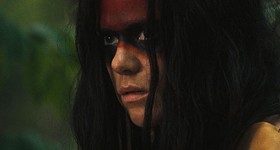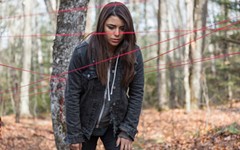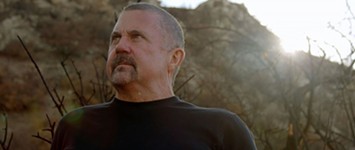DVDanger: 'Byzantium,' 'Kiss of the Damned,' 'Nosferatu,' 'Aeon: The Last Vampyre on Earth'
Time for a real vampire weekend
By Richard Whittaker, 9:00AM, Sun. Nov. 17, 2013

There are two kinds of vampire. Sexy and pained, or a walking virus. Personally, I have always preferred the "needs to be eradicated like smallpox" take.
I don't care about vampires' hierarchies, their social lives, or when they dined with Admiral Nelson. I just want to know if they burn up in sunlight. And just so we clarify, if you sparkle and hang out in high schools mooning over girls 200 years younger than you, then you're not a vampire. You're just weird.
But back to the main point. My favorite vampire movies always center on the mythical monster as an affliction, an ailment, a predator. Whether they embrace their fate with evil glee, like the roving bandits of Near Dark, or at least feel a dash tortured (cf Jack Palance in the 1974 Bram Stoker's Dracula), they're still looking at humans as self-delivering bags of plasma.
The shadow of vampires has been hanging long over Austin this week, with big casting news about Robert Rodriguez's new TV adaptation of his horror/crime/comedy/gore crossover From Dusk Till Dawn. Coincidentally, this week also saw the release of the big bad blooduscking grandfather of the genre, F.W. Murnau's Nosferatu, in a two-disc edition from Kino Lorber.
The original mockbuster, the unsanctioned 1922 adaptation of Bram Stoker's Dracula shifts the action from England to Germany. Count Orlok (Max Schreck) lures lawyer Thomas Hutter (Gustav von Wangenheim) to his Transylvanian castle, and then follows him back to the fictional German city of Wisborg. There plague, death, and corruption follow him, as he becomes sinisterly obsessed with Hutter's wife, Ellen (Greta Schröder).
Nosferatu is to vampires what Night of the Living Dead is to zombies: Everything you think of, and everything that filmmakers afterwards either mimic or rebel against, come from it. That's because of two factors. One, Murnau's grasp of imagery: A frustrated painter, he was one of the first directors to truly understand how film and lenses worked. His shadows were black, his whites scorching, his framing impeccable. He understood that the screen is a place for art. Before his lens, collapsing postwar Germany became the rotting tableau against which pure horror stalks.
His masterpiece was completed by the second component: the performance of Shreck. So uncannily eerie, in 2001 pitch black horror comedy Shadow of the Vampire posited that the actor was a real vampire. Drawing on occult obsessions with the power of shadows, he is more than just an animal that dines through exsanguination. Shreck's Orlok is a demon, a spidery contortion of the human frame. By comparison, Bela Lugosi was a chubby guy in a cape.
Murnau's imagery is burned into the history of cinema. However, it's not like there's a shortage of DVDs of his most famous creation (that tends to happen when a film is out of copyright). So why lay down real cash on the coffin for the Kino version? Well, aside from an impeccable transfer of the 2007 restoration (with both English- and German-language interstitial cards) there's a fascinating (if slightly dry) documentary included. Murnau: The Language of Shadows is a redubbed version of Luciano Berriatúa's 2008 documentary Die Sprache der Schatten - Murnau: Die frühen Jahre und Nosferatu. Murnau expert/obsessive Berriatúa is faced with a major challenge: Most of the master's early work is lost. However, he has seemingly hunted down every rogue frame, every publicity shot, every scrap of advertising, to give context to the king of the expressionists. He even found an advert from the filmmakers asking for rats for the shoot. The hourlong doc, while dusty, is as close to definitive on the matter of the making as possible.
However, it's a little short on the artistry. That said, elsewhere on the disc there are some fascinating glimpses and scenes from several of Murnau's films that survive either in fragment or in full. Kino has already repackaged five of them – Faust, The Last Laugh, Tartuffe, The Haunted Castle, and The Finances of the Grand Duke. Their presence here reinforces that everything that now seems hinky or cheesy or risible about Nosferatu were deliberate decisions. He was making a period piece, but the plight that the count brings across Europe is clearly birthed from Murnau's experiences in the trenches of World War I.
Berriatua also puts the film into its true content. Murnau's pacifism, melded with the occult fascinations of producer Albin Grau and his Rosicrucian script writer Henrik Galeen, were birthed from the postwar fascination with global horror and menace. This isn't just the original vampire movie: It's also arguably the definitive film from Weimar-era Germany, where a culture of ideas and innovation survived near obliteration in the trenches.

If Orlok was the definitional plague-bearing parasite, then the modern taste for vampires as tortured, sub-Oscar Wilde hedonists started with Anne Rice's books, and broke into the cinematic mainstream when Tom Cruise hammed it up as Lestat in Interview with the Vampire: The Vampire Chronicles. Now director Neil Jordan is back at the crypt for another tale of tortured immortals with Byzantium.
In the last few years, Jordan has revisited two pivotal themes from his early, defining works. His big reveal from The Crying Game became the central theme in 2005's transgender comedy Breakfast on Pluto. Similarly, Interview was the go-to lacy drama for a generation of goths. By contrast, Byzantium is less Sisters of Mercy, more Death Cab for Cutie.
In his Anne Rice adaptation, he used the wampyr as a metaphor mixing AIDS and homosexuality. This time he turns vampirism into Napoleonic health care. Clara (Gemma Atherton) and Eleanor (Saoirse Ronan) are Dearg-due: The Irish vampire that seduces, then feeds. Clara indulges in prostitution as her way to pick up lunch to-go and cash to survive. Eleanor portrays herself as a merciful angel of death, taking only the sick and aging when they are prepared to die.
Adapting from Moira Buffini's play A Vampire Tale, Jordan picks and chooses his mythology: His creature of the night don't have issues with mirrors or daylight, and they're a little short in the dental department (instead depending on one long thumbnail.)
Boil it down, and it's really about familial relationships. Clare (Atherton wielding a South London accent like a mace) sees mortals as something to be used and abused, picking up orphaned shlub Noel (Daniel Mays) and turning his rambling guesthouse into a brothel. Eleanor (Ronan at her most ghostly and disconnected) grows tired of the predatory lifestyle, and has started to fall for cancer-ridden Frank (Caleb Landry Jones). And why not? He dresses like he just fell out of the early 19th century, waistcoats and all.
Where Byzantium falls down is that there seems little narrative clarity. Eleanor is bursting to tell her story, and in the play Buffini suggests it could all be her way of processing abuse memories. Overall, Jordan's desire to touch on the same issues of unreliable narrators that he also dabbled with in Interview never seems to quite work. It's really clear that the women are vampires, while Buffini's play made much more of the ambiguity. There's a little bit of a moral mishmash towards the end, with Clara recast as a vampiric Ms. 45, and an element of gender politics, with vampires presented as a boys' only club. Yet it's hamfistedly shoved into the last half hour, after only being teased before.
It also seems blind to the long, broad history of fanged freak features and the mythology itself. Jordan is clearly trying to make an arthouse vampire movie, but seems hazy on the genre. For some odd reason, the English pair use the term Soucriant (a Dominican blood-sucking witch) about themselves, even if the story itself depends heavily on Byron and Polidori's dour, windswept Gothic interpretation. In the extras, Buffini muses about how Twilight is making vampires heroes (no, it's making them twee). And I had to blink hard when producer Stephen Woolley claims that cinematic vampires have been predominantly male (Stephen: Go Google Ingrid Pitt or Jean Rollin or From Dusk Till Dawn, and we'll talk.)

Not so Xan Cassavetes, who has clearly watched her fair share of Eurotrash exsanguinations. Kiss of the Damned is drenched in the rich scarlet of European exploitation. No surprise, since her first feature – 2004's Z Channel: A Magnificent Obsession – is a love letter to a station that showed little but low-budget high drama.
Like Rollin and Franco, this is vampirism as the affliction of the rich and sophisticated. Djuna (Joséphine de La Baume) inhabits a wooden mansion, sleeping in the day and visiting the video store at night. That's where she meets Paolo (Milo Ventimiglia), who is OK that her "skin condition" that makes her "sensitive to light" also means she has to suck the blood of wildlife. So much so that he's quite happy to get bitten, transform, and hang out at the nice mansion. Unlike most vampires, those drawn by Cassavetes can eat coq au vin and chug martinis.
But Djuna has a Clara to her Eleanor: Her sister Mimi (Roxane Mesquida) who rolls through the afterlife a mix of Catherine Deneuve in The Hunger and Bill Paxton in Near Dark. Byzantium and Kiss share the thematic tension of sisterly hatred. Djuna just wants to have a nice house in the country with the odd night out at the local jazz club. Mimi enjoys rough sex and murder out back of the club.
Yes, it all harkens back to the sometimes tawdry world of Seventies European vampire sexploitation. Yet somehow, it works. Cassavetes clearly loves that era of cinema, down to her font choice for the titles. Unlike Jordan's studiously grand but bland palette, her vibe is coolly overblown. Sometimes it's very Jess Franco; sometimes it's Cinemax with a lot more blood. In places, it's actually borderline funny, because becoming a vampire seems to make you the most tedious bourgeois twits ever. Djuna and Paolo hang out at cocktail parties where the discussion is all about kosher organic blood and, oh, how you must definitely visit Rome, it's delightful at this time of year.
And then Mimi starts dragging random strangers home for threesomes in the living room, and it's a vampiric version of town mouse, country mouse. It gets even weirder when Michael Rappaport arrives as the world's least convincing literary agent.
Mimi's power plays and her thinly veiled attempts to seduce their fellow bloodsuckers back into their old, dark, hedonistic and simplistically aristocratic ways threaten to derail this jet-set existence. While Byzantium failed to merge its gender politics smoothly into its family narrative, seeming sometimes clunky, Cassavetes uses the film's sometimes campy form to throw in a splash of politics and class consciousness.

A surprising gem of the bloodsucking canon has emerged from the scalding pit that is Chemical Burn. The independent horror label specializes in the tiniest of tiny budgeted terrors, with all the risks that entails. Aeon: The Last Vampyre on Earth is a sealed bottle drama, bleak and merciless. In a name that gives a nod to the original cinematic vampire, Catherine Murnau (April Basile) is the last surviving human on Earth: A strange apocalypse is taking place outside of the collapsing cellar, and she is surrounded by death and rotting corpses. But she is not alone. Instead, her company is another who is the last of their kind: Aeon, the final vampire (played by director Daniel Falicki). Turns out, if there's nothing left to prey on, the predators die too.
This is amateur horror, and the threads occasionally show. But Falicki embraces the Gothic. When Aeon first appears, he is a silhouette against a blood red background, a scavenger king in a world of ruins. He runs at the role with raw fury, his body collapsing, leaking, vomiting, bleeding, corrupting in front of Catherine. It's genuinely creepy.
While Jordan and directors of his ilk constantly harp on about the agonies of immortal life, Falicki turns that whole idea on its head. This is a vampire facing the end of days. He's a virus with no host. It's I Am Legend taken to its logical conclusion, and that alone wins points.
Warren Croyle and Ryan Lieske's script culminates in a lengthy quasi-theological debate about the nature of the human soul, which is intended to bring the plot to a resolution. Throughout their encounter, Aeon teases Catherine with the idea that death will be absolute: But at least, if she sacrifices herself to him, there will still be a trace of her left. That one idea provides so much dramatic tension, giving Catherine real pause. However (and Jordan could probably learn from this, if he decides to recount stories within stories again), why should she trust a putrefying monster? The first few times he tried to eat her implies he may not be trustworthy.
Crawl past the restrictions of a super-low-budget production from quasi-pros, and this is a real surprise. Of these three recent creations, it's arguably the one that would give Murnau most pleasure.
Nosferatu (Kino Lorber), Kiss of the Damned (Magnet) and Byzantium (IFC) are available on DVD now. Aeon: The Last Vampire on Earth (Chemical Burn) is available via www.lastvampyre.net.
A note to readers: Bold and uncensored, The Austin Chronicle has been Austin’s independent news source for over 40 years, expressing the community’s political and environmental concerns and supporting its active cultural scene. Now more than ever, we need your support to continue supplying Austin with independent, free press. If real news is important to you, please consider making a donation of $5, $10 or whatever you can afford, to help keep our journalism on stands.
Richard Whittaker, April 19, 2018
Richard Whittaker, April 3, 2018
Richard Whittaker, July 21, 2018
Richard Whittaker, July 14, 2018
April 12, 2024
April 11, 2024
DVD Watch, DVDanger, 'Byzantium, Kiss of the Damned, Nosferatu, Aeon: The Last Vampyre on Earth, Magnet, IFC, Kino Lorber, Chemical Burn, Neil Jordan, F.W. Murnau, Xan Cassevetes, Daniel Falicki, Max Schrek, Gemma Atherton, Saoirse Ronan












